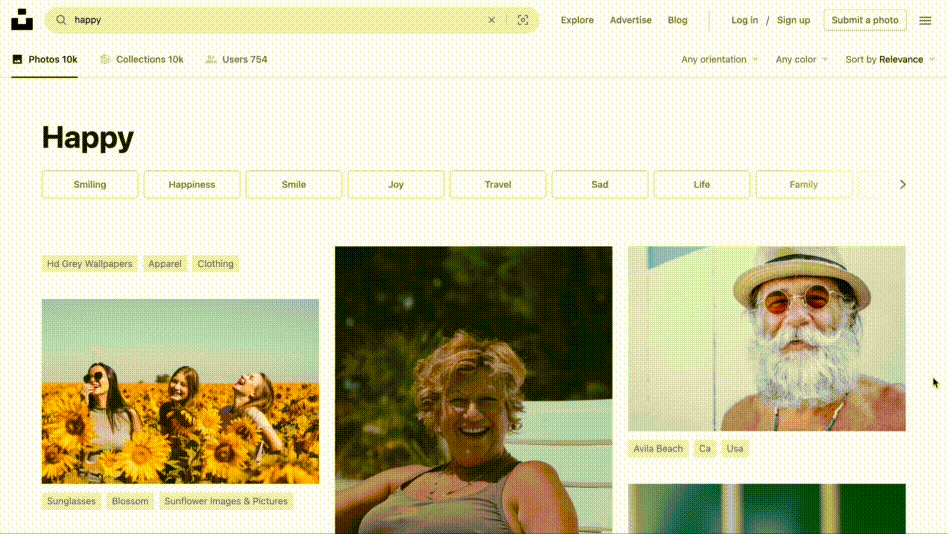High-quality smartphone cameras and relatively secure cloud services have convinced many creatives and makers that we alone can meet all our photography needs.
While you could use self-created photos for your next design project, chances are, the ones you have on hand don’t work. (However, if your project is about cats and their incredible cuteness, I have all the photos you’ll ever need.)
This is where stock photos can be very handy.
But, wait, why choose stock photos over custom photos? 🤔
The most obvious reasons are budget and time constraints. Ideally, you’d hire a professional photographer to take photos that are personal, unique, and tell your story exactly. But a photographer, casting, styling, a crew, and a location, among other expenses, can drive your budget way up and turn a one-day event into a three-month project.
Besides budget and time, there can be other challenges that make stock photos a good option:
- If you’re like us, your team is globally distributed, so getting all your departments in the same area code isn’t realistic.
- You have team members who are less than keen on being part of a photo shoot.
- You might need additional photos post-shoot for a piece of collateral. (In fact, that’s pretty much a given.)
Okay, I’m in. But how do I pick stock photos that don’t suck? 😅
If you think dating sites offer an endless array of disappointments options, you should see stock photo websites. (Or maybe you have and that’s why you’re here.) Luckily, you don’t need to swipe left or right on every single pic. However, there are a few things to keep in mind when looking for “the one”…erm…stock photo, that is.
1. Know What You Need
First, be aware of the context in which the photo will be used—both the narrative and technical context.
What I mean by narrative context is knowing what needs to be represented in the photo, what it should convey. Who or what should be in the picture? What’s the mood of the story you want to tell?
When you know that, you can define the subject of the photo. Let’s say you’re working on a medical research site, and you need media that fits the headline “Funding research for a better tomorrow.” You can search for a photo using the keyword “research” or you can search a more specific phrase, like “smiling woman in research lab.”
When there are too many results, try to narrow it down with detailed keywords that paint a more precise picture.

Next, consider the technical context. Essentially, that’s being aware of where the photo is going to be used. Do you need a landscape or a portrait? Is it going to be cropped?
If it’s part of a background and there’s going to be content over the photo, where should the subject be? What content is it going to be next to it? What resolution do you need (as that may determine pricing)?
Another factor that could influence your search for the perfect stock photo is brand context. If your company has photography guidelines, you should look for images that align with them to maintain a consistent look and feel.
2. Keep It Real
If you want photos that appear authentic and not overly stylized, here are a few things to look out for:
Pose
Overly posed or curated images will seem forced and too perfect. Instead, look for realistic poses and interactions.

Light
I know a stylized, dramatic look is tempting. But if you want your imagery to be relatable and rooted in reality, go for photos with soft, natural light. Avoid photos with harsh light or strong shadows.

Focus
A super detailed or patterned background will take attention away from the person in the frame. Photos will feel more organic and true-to-life with a soft focus and a clear distance between the foreground or background and the subject.

Clichés
You’ve seen them (e.g. stock photos featuring a group of corporate employees all high-fiving). Avoid them at all costs. Photos that are unoriginal and overused make your collateral feel fake fast.

3. Be Inclusive
Always make sure no one in your audience feels excluded—this is an extension of the “Keep it real” rule. People of all shapes and sizes, colors, backgrounds, and abilities might use your product or service. And featuring a wide variety of models in your images speaks to that diversity.

So where do I find good stock photos? 😬
There are a bunch of sites you can dig into (and potentially spend tons of time on). This is where sites that offer stock photos for sale usually have an advantage: better filtering options to help you find the perfect image quicker.
Free stock photo sites, on the other hand, tend to have more realistic options as both amateur and professional photographers contribute to their imagery pools.
Ready to start your stock photo search? Check out some of our favorite sources:
- unsplash.com (free)
The mother of free stock photography—a wide range of beautifully crafted shots
- stocksy.com (paid)
Gorgeous photos and videos, sometimes crossed with art and a bit of edge
- deathtothestockphoto.com (paid subscription)
Help fund artists who create fresh and authentic photography
- nappy.co (free)
Tackling diversity and representation with beautiful stock photos of Black and Brown people
- offset.com (paid)
The curated little brother of Shutterstock
You did it! You made it to the end of this post. You’re now armed with all the wisdom and tools to find that needle in a haystock. 😉 Go forth and make us proud, you crazy little thing.
